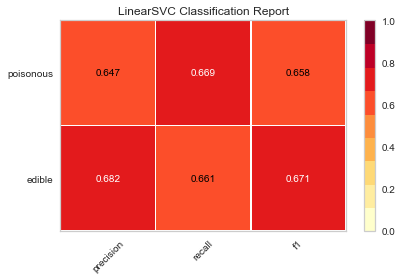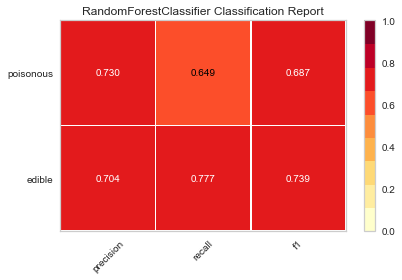Python機器學習之資料探索視覺化庫yellowbrick-tutorial
背景介紹
從學sklearn時,除了演算法的坎要過,還得學習matplotlib視覺化,對我的實踐應用而言,視覺化更重要一些,然而matplotlib的易用性和美觀性確實不敢恭維。陸續使用過plotly、seaborn,最終定格在了Bokeh,因為它可以與Flask完美的結合,資料看板的開發難度降低了很多。
前陣子看到這個庫可以較為便捷的實現資料探索,今天得空打算學習一下。原本訪問的是英文文件,結果發現已經有人在做漢化,雖然看起來也像是谷歌翻譯的,本著拿來主義,少費點精力的精神,就半抄半學,還是發現了一些與文件不太一致的地方。
# http://www.scikit-yb.org/zh/latest/tutorial.html
模型選擇教程
在本教程中,我們將檢視各種 Scikit-Learn 模型的分數,並使用 Yellowbrick 的視覺化診斷工具對其進行比較,以便為我們的資料選擇最佳模型。
模型選擇三元組
關於機器學習的討論常常集中在模型選擇上。無論是邏輯迴歸、隨機森林、貝葉斯方法,還是人工神經網路,機器學習實踐者通常都能很快地展示他們的偏好。這主要是因為歷史原因。儘管現代的第三方機器學習庫使得各類模型的部署顯得微不足道,但傳統上,即使是其中一種演算法的應用和調優也需要多年的研究。因此,與其他模型相比,機器學習實踐者往往對特定的(並且更可能是熟悉的)模型有強烈的偏好。
然而,模型選擇比簡單地選擇“正確”或“錯誤”演算法更加微妙。實踐中的工作流程包括:
選擇和/或設計最小和最具預測性的特性集
從模型家族中選擇一組演算法,並且
優化演算法超引數以優化效能。模型選擇三元組 是由Kumar 等人,在 2015 年的 SIGMOD 論文中首次提出。在他們的論文中,談論到下一代為預測建模而構建的資料庫系統的開發。作者很中肯地表示,由於機器學習在實踐中具有高度實驗性,因此迫切需要這樣的系統。“模型選擇,”他們解釋道,“是迭代的和探索性的,因為(模型選擇三元組)的空間通常是無限的,而且通常不可能讓分析師事先知道哪個(組合)將產生令人滿意的準確性和/或洞察力。”
最近,許多工作流程已經通過網格搜尋方法、標準化 API 和基於 GUI 的應用程式實現了自動化。然而,在實踐中,人類的直覺和指導可以比窮舉搜尋更有效地專注於模型質量。通過視覺化模型選擇過程,資料科學家可以轉向最終的、可解釋的模型,並避免陷阱。
Yellowbrick 庫是一個針對機器學習的視覺化診斷平臺,它允許資料科學家控制模型選擇過程。Yellowbrick 用一個新的核心物件擴充套件了Scikit-Learn 的 API: Visualizer。Visualizers 允許視覺化模型作為Scikit-Learn管道過程的一部分進行匹配和轉換,從而在高維資料的轉換過程中提供視覺化診斷。
關於資料
本教程使用來自 UCI Machine Learning Repository 的修改過的蘑菇資料集版本。我們的目標是基於蘑菇的特定,去預測蘑菇是有毒的還是可食用的。
這些資料包括與傘菌目(Agaricus)和環柄菇屬(Lepiota)科中23種烤蘑菇對應的假設樣本描述。 每一種都被確定為絕對可食用,絕對有毒,或未知的可食用性和不推薦(後一類與有毒物種相結合)。
我們的檔案“agaricus-lepiota.txt”,包含3個名義上有價值的屬性資訊和8124個蘑菇例項的目標值(4208個可食用,3916個有毒)。
讓我們用Pandas載入資料。
import os
import pandas as pd
mushrooms = 'data/shrooms.csv' # 資料集
dataset = pd.read_csv(mushrooms)
# dataset.columns = names
dataset.head()| id | class | cap-shape | cap-surface | cap-color | bruises | odor | gill-attachment | gill-spacing | gill-size | ... | stalk-color-above-ring | stalk-color-below-ring | veil-type | veil-color | ring-number | ring-type | spore-print-color | population | habitat | Unnamed: 24 | |
|---|---|---|---|---|---|---|---|---|---|---|---|---|---|---|---|---|---|---|---|---|---|
| 0 | 1 | p | x | s | n | t | p | f | c | n | ... | w | w | p | w | o | p | k | s | u | NaN |
| 1 | 2 | e | x | s | y | t | a | f | c | b | ... | w | w | p | w | o | p | n | n | g | NaN |
| 2 | 3 | e | b | s | w | t | l | f | c | b | ... | w | w | p | w | o | p | n | n | m | NaN |
| 3 | 4 | p | x | y | w | t | p | f | c | n | ... | w | w | p | w | o | p | k | s | u | NaN |
| 4 | 5 | e | x | s | g | f | n | f | w | b | ... | w | w | p | w | o | e | n | a | g | NaN |
5 rows × 25 columns
features = ['cap-shape', 'cap-surface', 'cap-color']
target = ['class']
X = dataset[features]
y = dataset[target]dataset.shape # 較官方文件少了倆蘑菇(8122, 25)dataset.groupby('class').count() # 各少了1個蘑菇| id | cap-shape | cap-surface | cap-color | bruises | odor | gill-attachment | gill-spacing | gill-size | gill-color | ... | stalk-color-above-ring | stalk-color-below-ring | veil-type | veil-color | ring-number | ring-type | spore-print-color | population | habitat | Unnamed: 24 | |
|---|---|---|---|---|---|---|---|---|---|---|---|---|---|---|---|---|---|---|---|---|---|
| class | |||||||||||||||||||||
| e | 4207 | 4207 | 4207 | 4207 | 4207 | 4207 | 4207 | 4207 | 4207 | 4207 | ... | 4207 | 4207 | 4207 | 4207 | 4207 | 4207 | 4207 | 4207 | 4207 | 0 |
| p | 3915 | 3915 | 3915 | 3915 | 3915 | 3915 | 3915 | 3915 | 3915 | 3915 | ... | 3915 | 3915 | 3915 | 3915 | 3915 | 3915 | 3915 | 3915 | 3915 | 0 |
2 rows × 24 columns
特徵提取
我們的資料,包括目標引數,都是分型別資料。為了使用機器學習,我們需要將這些值轉化為數值型資料。為了從資料集中提取這一點,我們必須使用Scikit-Learn的轉換器(transformers)將輸入資料集轉換為適合模型的資料集。幸運的是,Sckit-Learn提供了一個轉換器,用於將分類標籤轉換為整數: sklearn.preprocessing.LabelEncoder。不幸的是,它一次只能轉換一個向量,所以我們必須對它進行調整,以便將它應用於多個列。
有疑問,這個蘑菇分類就是一個向量?
from sklearn.base import BaseEstimator, TransformerMixin
from sklearn.preprocessing import LabelEncoder, OneHotEncoder
class EncodeCategorical(BaseEstimator, TransformerMixin):
"""
Encodes a specified list of columns or all columns if None.
"""
def __init__(self, columns=None):
self.columns = [col for col in columns]
self.encoders = None
def fit(self, data, target=None):
"""
Expects a data frame with named columns to encode.
"""
# Encode all columns if columns is None
if self.columns is None:
self.columns = data.columns
# Fit a label encoder for each column in the data frame
self.encoders = {
column: LabelEncoder().fit(data[column])
for column in self.columns
}
return self
def transform(self, data):
"""
Uses the encoders to transform a data frame.
"""
output = data.copy()
for column, encoder in self.encoders.items():
output[column] = encoder.transform(data[column])
return output建模與評估
評估分類器的常用指標
精確度(Precision) 是正確的陽性結果的數量除以所有陽性結果的數量(例如,我們預測的可食用蘑菇實際上有多少?)
召回率(Recall) 是正確的陽性結果的數量除以應該返回的陽性結果的數量(例如,我們準確預測了多少有毒蘑菇是有毒的?)
F1分數(F1 score) 是測試準確度的一種衡量標準。它同時考慮測試的精確度和召回率來計算分數。F1得分可以解釋為精度和召回率的加權平均值,其中F1得分在1處達到最佳值,在0處達到最差值。
precision = true positives / (true positives + false positives)
recall = true positives / (false negatives + true positives)
F1 score = 2 * ((precision * recall) / (precision + recall))
現在我們準備好作出一些預測了!
讓我們構建一種評估多個估算器(multiple estimators)的方法 —— 首先使用傳統的數值分數(我們稍後將與Yellowbrick庫中的一些視覺化診斷進行比較)。
from sklearn.metrics import f1_score
from sklearn.pipeline import Pipeline
def model_selection(X, y, estimator):
"""
Test various estimators.
"""
y = LabelEncoder().fit_transform(y.values.ravel())
model = Pipeline([
('label_encoding', EncodeCategorical(X.keys())),
('one_hot_encoder', OneHotEncoder(categories='auto')), # 此處增加自動分類,否則有warning
('estimator', estimator)
])
# Instantiate the classification model and visualizer
model.fit(X, y)
expected = y
predicted = model.predict(X)
# Compute and return the F1 score (the harmonic mean of precision and recall)
return (f1_score(expected, predicted))from sklearn.svm import LinearSVC, NuSVC, SVC
from sklearn.neighbors import KNeighborsClassifier
from sklearn.linear_model import LogisticRegressionCV, LogisticRegression, SGDClassifier
from sklearn.ensemble import BaggingClassifier, ExtraTreesClassifier, RandomForestClassifiermodel_selection(X, y, LinearSVC())0.6582119537920643import warnings
warnings.filterwarnings("ignore", category=FutureWarning, module="sklearn") # 忽略警告model_selection(X, y, NuSVC())0.6878837238441299model_selection(X, y, SVC())0.6625145971195017model_selection(X, y, SGDClassifier())0.5738408700629649model_selection(X, y, KNeighborsClassifier())0.6856846473029046model_selection(X, y, LogisticRegressionCV())0.6582119537920643model_selection(X, y, LogisticRegression())0.6578749058025622model_selection(X, y, BaggingClassifier())0.6873901878632248model_selection(X, y, ExtraTreesClassifier())0.6872294372294372model_selection(X, y, RandomForestClassifier())0.6992081007399714初步模型評估
根據上面F1分數的結果,哪個模型表現最好?
視覺化模型評估
現在,讓我們重構模型評估函式,使用Yellowbrick的ClassificationReport類,這是一個模型視覺化工具,可以顯示精確度、召回率和F1分數。這個視覺化的模型分析工具集成了數值分數以及彩色編碼的熱力圖,以支援簡單的解釋和檢測,特別是對於我們用例而言非常相關(性命攸關!)的第一類錯誤(Type I error)和第二類錯誤(Type II error)的細微差別。
第一類錯誤 (或 "假陽性(false positive)" ) 是檢測一種不存在的效應(例如,當蘑菇實際上是可以食用的時候,它是有毒的)。
第二類錯誤 (或 “假陰性”"false negative" ) 是未能檢測到存在的效應(例如,當蘑菇實際上有毒時,卻認為它是可以食用的)。
from sklearn.pipeline import Pipeline
from yellowbrick.classifier import ClassificationReport
def visual_model_selection(X, y, estimator):
"""
Test various estimators.
"""
y = LabelEncoder().fit_transform(y.values.ravel())
model = Pipeline([
('label_encoding', EncodeCategorical(X.keys())),
('one_hot_encoder', OneHotEncoder()),
('estimator', estimator)
])
# Instantiate the classification model and visualizer
visualizer = ClassificationReport(model, classes=['edible', 'poisonous'])
visualizer.fit(X, y)
visualizer.score(X, y)
visualizer.poof()visual_model_selection(X, y, LinearSVC())
# 其他分類器視覺化略
visual_model_selection(X, y, RandomForestClassifier())
檢驗
現在,哪種模型看起來最好?為什麼?
哪一個模型最有可能救你的命?
視覺化模型評估與數值模型評價,體驗起來有何不同?準確率Precision召回率Recall以及綜合評價指標F1-Measure
http://www.makaidong.com/%E5%8D%9A%E5%AE%A2%E5%9B%AD%E7%83%AD%E6%96%87/437.shtml
f1-score綜合考慮的準確率和召回率。
視覺化就是直觀嘛,逃~
作者簡介
知乎yeayee,Py齡5年,善Flask+MongoDB+SKlearn+Bo
